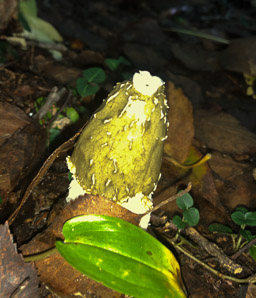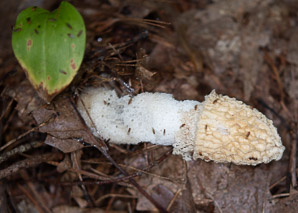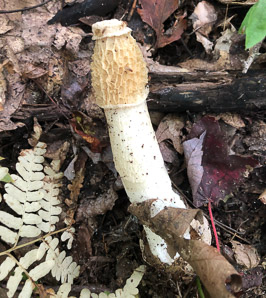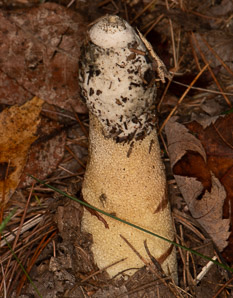
|
Phallus impudicus L. 1753 Common stinkhorn
What a weird fungus! First of all, it smells “atrocious,” like rotting flesh. Second, it is shaped like a phallus: Phallus impudicus means “shameless or immodest phallus.” Before Linneaus got involved—reaching even further back in botanical nomenclature time—others invented colorful names as well. From Wikipedia: “Botanist John Gerard called it the ‘pricke mushroom’ or ‘fungus virilis penis effigie’ in his General Historie of Plants of 1597, and John Parkinson referred to it as ‘Hollanders workingtoole’ or ‘phallus hollandicus’ in his Theatrum botanicum of 1640.” Third, it has a slimy, wrinkled head, the source of the bad smell. Fourth, common stinkhorn makes its impudent appearance in even the most proper and meticulously maintained of gardens, favoring damp wood mulch, and growing at a surprising rate. Fruits: Fruits start out as an egg-shaped object, sometimes called a witch’s egg, which is whitish or pinkish in color. The egg is 1½-2″ (4-6 cm) × 1-1¾″ (3-5 cm). The mushroom breaks through its outer coating, the volva. Next, it grows at an astonishing rate of up to ten inches per hour, on a white stalk. It may reach up to 10″ (25 cm) in height. Caps are ½-1½″ (1.5-4 cm) around, not a great deal wider than the stalks. They appear from June to October. Most mushroom stalks are soft, but these are quite hard, and hollow, like a polystyrene (plastic foam) tube. The tip is covered by a wrinkly, slimy, decidedly stinky, olive-colored gleba, which contains the spores. The odor attracts flies, which help to distribute the spores. The tip somewhat resembles morel mushrooms, especially after insects have stripped it. Spores: If you are handy with a microscope, the spores are 3.5 µ x 1.5-2.5 µ, and elliptical or oblong in shape, with smooth surfaces. Edibility: Well let’s see ... phallic, slimy, stinky ... but yes, technically, they’re edible, or at least non-toxic. It is scary to think about how hungry you need to be to experiment with such an unsavory-appearing fungus. Portions of the fungus can be eaten raw at the egg stage, and are said to have a radishy taste. And here is a recipe, and other information, from MushroomKnowhow.com. Toxicity has been reported in small or immature dogs, and not everyone responds the same way to mushrooms, so eating them isn't a great idea. Medical: There is some evidence that the mushroom contains compounds that may treat certain cancers, or act as anticoagulants. Online References:
Michael Kuo's MushroomExpert.com 9/29/2018 · Jason’s Cutoff, Beaver Brook Con, Hollis, New Hampshire, United States
Phallus impudicus description by Thomas H. Kent, last updated 6 May 2023. © FloraFinder.org. All rights reserved. |
I think the insects eating this mushroom are blow flies (Calliphora vicina). · 9/15/2018 · Oak Hill, Littleton, Massachusetts · ≈ 8 × 5″ (20 × 13 cm) 9/30/2018 · Miller State Park, Pack Monadnoc, Peterborough, New Hampshire, United States 10/10/2021 · Witt’s End Trail, Norway, Maine · ≈ 5 × 8″ (13 × 20 cm) 9/30/2018 · Miller State Park, Pack Monadnoc, Peterborough, New Hampshire, United States 10/10/2021 · Witt’s End Trail, Norway, Maine · ≈ 4½ × 7″ (11 × 17 cm)
|







